The Chainsaw Man opening, which was directed by Shingo Yamashita and was set to the song Kick Back by Kenshi Yonezu, is one of the most creatively stacked anime openings of the decade. The series is based on the acclaimed manga of Tatsuki Fujimoto about Denji, a down-on-his-luck devil hunter who becomes Chainsaw Man by merging with his pet devil Pochita. Although the gritty tone of the anime and its brutal storytelling have been popular with the viewers, it is the opening sequence that won some accolades as a seamless integration of numerous movie references, not only to classic films of the West but also to psychological thrillers and even cult horror, without detracting from the anarchic mood of the series.
The opening of Chainsaw Man uses more than fifteen different movie references, all of which are connected to either a shot or a visual composition in the opening sequence. These are not stylistic winks but calculated visual resemblances that are meant to reflect the tone, theme, and character of each scene. The outcome is a film montage that manifests the passion of Tatsuki Fujimoto for the film and the absurd yet deep plot of the anime.
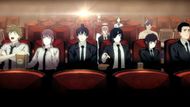
Every single image of the Chainsaw Man opening performs a narration or symbolic role. The sources are arranged in chronological order, which gives the fans a feeling of a procession that shifts between surreal images and apocalyptic violence, which reflects the same transition of Denji descending into chaos. The pacing of the animation and transitions of the scenes prove that the production team had a perfect mastery of utilizing cultural homage with original visual storytelling.
Chainsaw Man and its cinematic inspirations
1. Dante’s Divine Comedy
The initial mention is in the ignition scene where Chainsaw Man is buzzing his chainsaw on a demonic background - a visual composition that is similar to the one of the Divine Comedy (Dante). This first shot is a reference to the fall into hell and the lawlessness that characterizes the series.
2. Reservoir Dogs (1992)
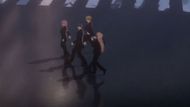
Next, right after, the shot shifts to a close-up of the faces of the individual characters, the same composition as the introduction of Reservoir Dogs (1992). It represents the collective life of the Devil Hunters and exposes the personality of each of the team members with minimal framing, but also unveils their personalities.
3. The Texas Chainsaw Massacre (1974)

An illustration of youthful Denji holding Pochita is given below, and it reminds us of The Texas Chainsaw Massacre (1974). The harsh lighting and semi-dark feeling provide the impression of horror, which is comparable to the savagery of Denji and the eventual transformation into a killing machine.
4. Pulp Fiction (1994)

The following image of Kishibe with a gun that is pointed directly at the camera reminds one of the classic gunfire scene in Pulp Fiction (1994) that serves as a symbol to represent his cold-blooded accuracy as both a teacher and a killer.
5. Sadako vs. Kayako (2016)
The haunted image of Sadako vs. Kayako (2016) is soon reinvigorated on a supernatural flying jump over a well, which indicates the roots of Chainsaw Man in the Japanese horrors.
6. No Country for Old Men (2007)
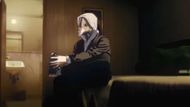
This is then changed by a shot where the bird masked figure tightens his shoes, with visual allusions to No Country for Old Men (2007). This intentional imitation of the technique used by Anton Chigurh to plot the murder is indicative of the silence of menace that exists in the antagonists of Chainsaw Man.
7. Once Upon a Time in Hollywood (2019)
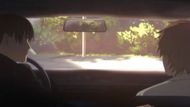
In the next sequence, we observe the backs of characters' heads sitting in a car, which is an explicit allusion to Once Upon a Time in Hollywood (2019) and the nostalgia around framing and dialogue tension created by Tarantino.
8. Attack of the Killer Tomatoes (1978)
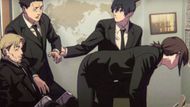
The anarchic meeting room shot a bit later, with one of the members crouching on the top of a table, reminds one of Attack of the Killer Tomatoes (1978), which also adds to the narrative mayhem with the elements of dark comedy.
9. Don’t Look Up (2021)

Then, there is a shocked Denji with Power standing at the backdrop, an allusion to Don’t Look Up (2021), an expression that shows the absurdity and denial that exist during an apocalypse.
10. Jacob’s Ladder (1990)

The following shot, in which Angel Devil is sitting on the bottom of the stairs, makes a visual connection with Jacob's Ladder (1990), where the reference is made to psychological horror and spiritual corruption.
11. Constantine (2005)
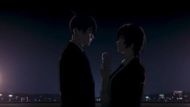
It is also comparable to the case of Constantine (2005), in which the similarity is that the intimate encounter of Aki with Himeno portrays his moral dilemma and sadness.
12. The Big Lebowski (1998)

Then the bowling alley scene, with its colorful reference to The Big Lebowski (1998) and a sense of humor playing second fiddle to existential undertones, follows.
13. Thor: Love and Thunder (2022)
Subsequently, a moment of explosive mayhem is followed by a series of radiance with Power's name card that recalls Thor: Love and Thunder (2022), which suits the hyperbole of a character of Power on a larger-than-life scale.
14. Neon Genesis Evangelion (1995)
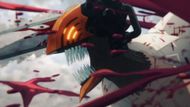
The scene of the Chainsaw Man carnage with red filters and fluid animation aesthetically recalls the Neon Genesis Evangelion (1995) with its sense of destruction that is imminent.
15. Fight Club (1999)
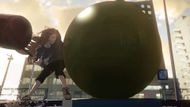
An ensuing shot of a big rolling ball that crashes into Power and finally destroys it resembles Fight Club (1999), which is an indication of anarchy and a loss of control.
16. Fujimoto’s Own Explosion Scene

The image of power taking a cool stroll out of a blast is a direct resemblance to the manga of explosions in films by Fujimoto in general - another stylistic reflection of his art.
17. Perspective (Short Film Reference)
The last image illustrates Makima standing on a stack of books, and Aki on the floor behind a wall, a composition that is based on art-film cinematography and the focus on the short film Perspective.
All Cinematic Homages in the Chainsaw Man Opening Sequence
The Chainsaw Man introduction is a love letter to film, and it is created with accuracy and a profound underlying theme. Director Shingo Yamashita successfully combined visual nods and original narration to make the film an experience that could be paid attention to. Every film allusion is associated with an emotional character journey or the violent role of the show in general, commenting on violence, control, and liberation. The film influence is also an indication of the love of film by Tatsuki Fujimoto, who mentions it in several instances in his manga.
The introduction indicates the cross-cultural appreciation and experimentation in narration by the creator by referring to both Western and Japanese cinema. All the homages, like the stylization of the picture in Reservoir Dogs and the apocalyptic perspective of Neon Genesis Evangelion, are combined with the aesthetics of Chainsaw Man, which is the confirming evidence that the homage and the originality can be a marriage. It is one of the best introductory anime directions, which jumps across the boundaries of various genres - it is a horror, a comedy, and existentialism in one memorable sequence.
